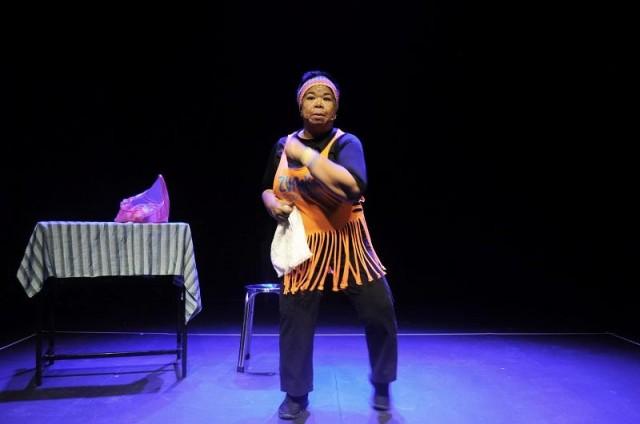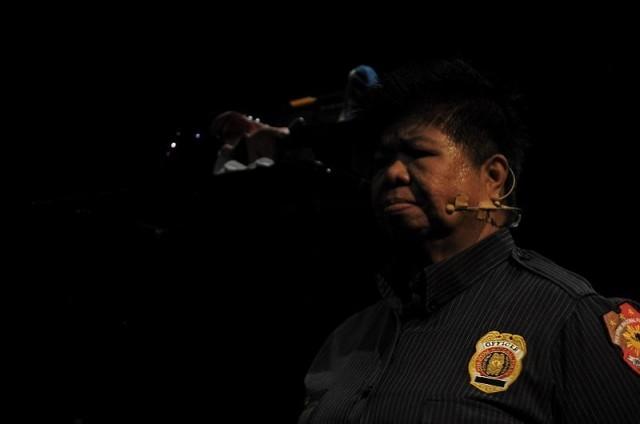In a play about the drug war, Mae Paner portrays both victim and killer
“Tao po” used to be among the friendliest greetings in Filipino culture, often accompanied by a gentle knock on a neighbor’s door. It was a verbal signal of good intent before entering, or a warm query at an unmanned sari-sari store. As warm as the Bisayan word tokhang was in another era.
In “Tao Po,” the traveling one-woman play about our times starring Mae Paner, the friendly greeting is transformed into an anguished plea to be considered human.
In one of the four compelling monologues in the play, all exploring different intimately personal takes on the drug war, Paner playfully emerges on stage in an exercise suit to lead her jologs neighbors in a zumba activity for admitted drug users.

They all, presumably, volunteered for a rehab program that includes this community pastime, similar to what has occurred since the drug war exploded in many slums like the one portrayed on this stage.
I’ve seen one of these surreal drug-war zumbas myself in a crowded barangay, with cackling laughter mixed with unveiled threats from a tall retired cop, before the dancers were made to fall in line for urine drug tests to prove that they have taken the threats seriously.
Paner in this sketch is a recognizably crass urban character, a roly-poly toughie who makes filthy fun of her physique while gracelessly ribbing others. She could easily pass for one of those purok leaders tasked with drawing up local narco lists of shady neighbors.
But amid the taunts, the grisly bits and pieces of her story begin to leak out, as she addresses two men who we learn have become ghosts: her affectionate, drug-running husband Marcelo, and her son Jojo, a young father who has left her a baby to raise when both husband and son were recently dragged out of their home and killed by men in uniform.
Her vulgar wisecracks gradually segue into a tormented narration of her family’s blood-soaked tragedy, but also an honest admission of their petty involvement in drugs.
“Sabi nila, ang mga adik hindi na raw tao kundi mga halimaw. Si Marcelo ko? Si Jojo? Halimaw?… Tao po ang mag-ama ko, Kap. Tao po!”
("They say drug addicts are monsters. But my husband Marcelo? My son Jojo? Monsters? They are people! People!')
Embedded in her story is a microcosm of the drug war from the victimized family’s point of view, the murders just the start of her Calvary of funeral costs, debt, and stigmatization; and wretched questions about her loss, like why her loved ones were not given the benefit of rehab like her neighbors. Perhaps because like thousands of others, they had conveniently resisted so that the police raiding team had no choice but to end the two lives despite vastly outnumbering them.
It’s a familiar enough story, based on Paner’s and playwright Maynard Manansala’s immersion to research the lives of the urban poor communities where much of the killing has taken place. Paner’s character is actually based on a real mother and wife who also lost son and husband on the same night.
Even without the immersion, one need only watch the news to know this kind of atrocity has been going on. But after nearly three years of the drug war and no end in sight, so-called “extrajudicial killings” or EJKs rarely lead the news anymore, and are often relegated to debates about statistics and semantics.
The police will admit to only five thousand or so killings, as if it’s a more excusable number than the 20,000 or so that human rights groups have estimated. The police refuse to call them EJKs, insisting on “deaths under investigation,” but with the police’s “presumption of regularity” despite stunning clues of common irregularity.
“Tao Po” walks audiences numbed by death stats and diversionary debates through the catacomb of grief and agony that scores of families have had to navigate alone. Makes one wonder what kind of people would subject others to this endless torture.
The next monologue tries to produce some answers, as Mae Paner re-enters the stage as the opposite of the grieving wife and mother.
From plump matron, she is now a hefty swaggering man, a trained assassin and a composite of the various true characters that have confessed to killing as a profession on national TV, from Matobato and Lascañas to the men in silhouette who dared speak to the media for the last three years.
The killer on stage describes a childhood made inured to blood and gore by a sabungero father who forced him to butcher a dying defeated chicken. Then in a chilling litany, the professional describes the clinical ways of killing, even the elderly and a child who happened to witness him and his cohorts murder his parents.
In one passage, he recalls the moment that exterminating life began to feel like an act of heroism:
Nanghihinayang daw ba ‘ko sa buhay ng adik? ‘Yang mga adik, pumapatay ‘yan, nangrereyp ‘yan. Sila ang mga salot ng lipunan, kaya sila ang dapat ubusin... Isang putok sa sentido, para sa taong pinatay. Isang putok sa dibdib, para sa babaeng nireyp. Lampas na sa lima ang napatay ko nu’ng may maramdaman akong kakaiba. ‘Yun bang para akong bayani.
(Do I feel sorry for killing addicts? Drug addicts kill. They rape. They're the real problem and they must die. A shot to the head for a person they've killed. A bullet to the chest for a woman they've raped. It was only after killing more than five drug addicts when I began to feel like a hero.)
When he learns that his own brother was killed, the killer even rationalized it to his father as the price of justice. But then doubts about this moral code creep in, when he’s about to apprehend a wealthy drug trafficker on his hit list. The killer receives a call from the mayor’s son who tells him to spare his friend’s life as a birthday gift. “Putangina, sinakripisyo mo ang sarili mong kapatid...” the killer tells himself after watching the wealthy pusher drive away.
The killer reveals all this to the audience while polishing his gun, his pride, with tender loving care. Then in a dramatic final jolt he puts on a police uniform and prepares for a media interview by practicing familiar lines about neutralizing addicts to make us all safer, including this one that attributes to human error the occasional mistaken identity: “Hindi kami perpekto, mam, tao lang kami. Tao po, nagkakamali rin.”
("We are not perfect, ma'am. We are also people. We commit mistakes.")

All this of course is fiction, but only in the way that art imitates life or even current events, the artist’s imagination filling in the details of a crime scene’s chalk outline with color and emotion.
Mae Paner’s opus opened in 2017 in the Cultural Center of the Philippines of all places. This was of course Imelda’s former palace; in the current political climate, it’s not inconceivable that politically edgy productions like “Tao Po” may no longer be welcome before a certain term ends. That is, if protest art like “Tao Po” will have no short-term impact at all in changing hearts and minds.
Directed by Ed Lacson, Jr., “Tao Po” has toured various university venues, playing mostly to sympathetic and discerning audiences (I saw it for the first time last March at the Ateneo de Manila University campus). The real test now for this performance’s power is in the lions’ dens of city halls and barangay halls, the LGU lairs where the drug war harbors its most fanatical supporters as well as finds the majority of its victims.
Part of the potency of “Tao Po” is it cannot be dismissed as just another dilawan gimmick, if one is aware at all of Mae Paner’s history as a gadfly despised by the circles around PNoy in a previous era. One could say she was a political troll before they were bred in today’s troll farms.
If the press has its cherished freedom, the artist does too, and in “Tao Po” is a portrait of a versatile artist roaming an ample creative space to speak certain naked truths to power.
Those of us who have been covering the drug war as journalists, and witnessed the every-day brutality, grief, and lies, watch “Tao Po” with no small measure of catharsis, as well as satisfaction that the issues we’ve covered have found new life for new audiences.
Sure enough, the opening monologue has Mae Paner playing photojournalist Raffy Lerma, the former Inquirer news photographer who, early in the drug war, shot the now iconic “Pieta” picture of a slain pedicab driver in Pasay being cradled by his weeping widow. The photo went around the globe, alerting the world to an unparalleled ruthlessness aimed at the poorest of the poor.
Yet it continues to happen three years later, making some journalists question whether they are making any impact at all in a society that increasingly values loyalty over truth or even justice. Seeing one of the brethren portrayed on stage to prick a collective conscience suggests that the exasperating, traumatic work of witnessing brutality and gross injustice may have some value after all.
After each performance, Mae Paner, Raffy Lerma, and other resource persons form a “talk-back” panel on stage that answers questions and helps an affected audience process the experience, almost like therapy for a representative part of that population which refuses to applaud or ignore savagery that’s become commonplace. One VIP viewer at the show that I saw shared that watching it finally allowed him to grieve.
Each monologue is an unpeeling of a fresh scab, with the fourth and last vignette the most heart-breaking of all, featuring Mae Paner’s most challenging role. I’ve revealed enough, and won’t spoil the ending for you. Besides, it’s just too painful to describe. — LA, GMA News
The next “Tao Po” show will be on April 16 at 7 PM at the PETA Theater Center in Quezon City.





